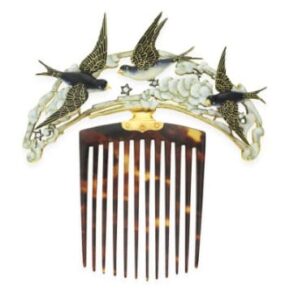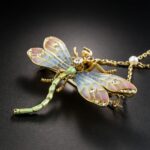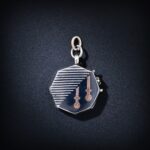 French jeweller known for Japanese motif jewellery and mixed metals work. In 1860, Ernest Gaillard took over his father’s Parisian jewellery workshops.1 Though the workshops had, until then, produced primarily gilt copper jewels, Ernest changed its focus to silver jewellery. During the 1870s and ’80s, he experimented with different kinds of patination as well as with enamels, niello, and Japanese-style inlay work. In 1878, his work won a silver medal at Paris’s International Exposition. In 1889, he was awarded a Legion of Honor cross for his innovative technical contributions to the trade.
French jeweller known for Japanese motif jewellery and mixed metals work. In 1860, Ernest Gaillard took over his father’s Parisian jewellery workshops.1 Though the workshops had, until then, produced primarily gilt copper jewels, Ernest changed its focus to silver jewellery. During the 1870s and ’80s, he experimented with different kinds of patination as well as with enamels, niello, and Japanese-style inlay work. In 1878, his work won a silver medal at Paris’s International Exposition. In 1889, he was awarded a Legion of Honor cross for his innovative technical contributions to the trade.
In 1892, Gaillard handed over the business to his son, Lucien. Since 1878, Lucien had been eagerly waiting in the wings. “A tireless worker who was captivated by his work,” says Vever, “Gaillard enthusiastically studied all its technical aspects, including alloys, gilding, and patinas, and achieved fascinating results.”2 At the 1889 Parisian International Exhibition, he was awarded a gold medal for his engraved objects. At the Exhibition in 1900, he displayed an impressive array of silver vases, remarkable for their subtle, alluring patinas. Though he left without winning a prize, Gaillard came away with a new source of inspiration: the jewellery of René Lalique.
Thereafter, Gaillard began creating Art Nouveau jewels of his own. His pieces were impressive and won him acclaim at various Parisian Salons from 1902 to 1904. The designs had a distinctly Japanese feel, featuring stylized insects, flowers, and trees. This is not surprising, as he employed Japanese craftsmen in his Parisian workshop.3 The pieces they created with Gaillard and his Parisian staff typically featured organic materials like horn and ivory. If gold or silver were used, the metal was given a soft patina and, typically, embellished with enamels, engraving, or both.
Maker's Marks & Timeline
Gaillard
| Country | |
|---|---|
| City | Paris |
| Symbol | cartouche, diamond, frame, lozenge, rhombus |
| Shape | cartouche, frame, lozenge, rhombus |
| Era | 1840-1933 |
Specialties
1840
- Firm Founded by Amédée Gaillard.
- Made gilt copper jewels.
1860
- Son Ernst took over the firm.
- Made silver jewels.
1861
- Birth of Lucien Gaillard
c.1869
- Worked in niello – unusual outside of Russia, Germany & Austria.
- Japanese-Style Inlay.
1878
- Lucien joins the firm as an apprentice.
- Interested in Japanese metal techniques.
1889
- International Exhibition, Paris – Gold Medal for Engraving and Legion d’Honnour.
1892
- Lucien took over the firm.
- Heavily influenced by Japanese art.
- Studied metallurgical procedures such as plating, patination and alloying.
- Enamel, Niello & Patination.
- Art Nouveau Jewels with Insects, Flowers & Trees – Featuring Organic Materials.
1900
- Grand Prix and the Paris World Exhibition in Bijouterie-Joaillerie.
1933
- Death of Lucien Gaillard.
Sources
- Becker, Vivienne, Art Nouveau Jewellery. New York: E.P. Dutton, 1985.
- Vever, Henri. French Jewelry of the Nineteenth Century. Translated by Katherine Purcell. London: Thames & Hudson, 2001 [1906-8].





